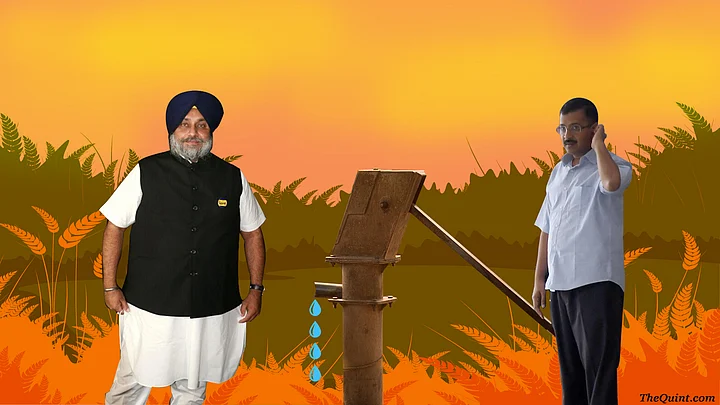As it fancies forming the next government in Punjab, Aam Aadmi Party (AAP) has claimed that it has a “comprehensive solution” for the agrarian state’s groundwater crisis if voted in. Punjab goes to the polls early next year.
The party claims that the issue of groundwater depletion will be completely taken care of in the next 10-15 years through effective policy-making and infrastructure development. This, the party says, “will begin soon after it assumes charge”.
However, Shiromani Akali Dal (SAD), which heads the coalition government in the state with the BJP, termed it a “hollow claim by a party which wants Punjab’s river water to go to other states”. This, SAD said, is despite the fact that “14 lakh tube-wells are being currently used by farmers in Punjab for drawing water”.
Rapid depletion of groundwater, which irrigates 73 percent of Punjab’s agricultural land, has emerged as a crucial challenge for the state.
AAP Has a Plan for Punjab’s Water Crisis
Chairman of AAP’s Election Manifesto Committee, Kanwar Sandhu, said the party will push a major crop-diversification programme for Punjab. This will involve the ‘AAP government’ raising funds for buying products other than rice and wheat from farmers. The party also plans to spend heavily on canal repairing, construction of new canals and water harvesting infrastructure. Also part of the blueprint is setting up of agro-industries in various areas for processing and value-addition of agricultural produce other than rice and wheat.
“This will encourage farmers to grow crops other than rice and wheat, which are water guzzlers,” Sandhu said.
For decades there has been no focus on repairing canals and building new canals, which has put pressure on groundwater. We have identified various areas which need new canals.Kanwar Sandhu, Chairman of AAP’s Election Manifesto Committee
Sandhu went on to say that the “AAP government would carry out de-siltation of Harike lake and would build small irrigation dams for storing the Ravi’s water, which usually flows to Pakistan”.
According to Sandhu, it is going to take 10 to 15 years for completing the infrastructural projects. “But policy decisions and developmental work will start soon after the AAP government takes over,” he said.And the results, he added, will start reflecting on the ground incrementally.
Akali Dal: Punjab Not Allowed to Use its Water
But AAP’s political opponent SAD is not impressed by its claims.
Such claims are being made by a party [AAP] which wants Punjab’s river waters to go to other states. This, despite the fact that 14 lakh tube-wells are being currently used by farmers in Punjab for drawing water.Daljit Singh Cheema, Spokesperson, Akali Dal
Cheema said that SAD would continue to be firm on its stand of not sharing Punjab’s river waters with Haryana and Rajasthan. The case of water-sharing between Punjab, Haryana, Himachal Pradesh (HP) and Rajasthan is currently in the Supreme Court (SC). The case was referred to the SC in 2004 by the president of India. This happened days after the then Congress government, led by Captain Amarinder Sigh, had passed the Punjab Termination of Waters Agreement in the state assembly. The President had to seek the SC’s opinion following stiff opposition from the three neighbouring states -- HP, Haryana and Rajasthan.
According to Cheema, the solution to Punjab’s water crisis lies in the retention of its river waters. This can do away with the need of using groundwater. “Obviously when we have enough surface water, why should we use ground water?” he said. He also accused AAP of not stating clearly that it supported Punjab’s right over its rivers.
Depletion of Groundwater
Having virtually ‘exported’ its groundwater to other states in India and to Pakistan, Punjab is poised for an economic disaster if it fails to fix the problem of rapid groundwater depletion.
Experts have called for a quick shift from water-intensive paddy and wheat -- which have guzzled up Punjab’s groundwater -- to crops such as pulses, maize, vegetables and sugarcane. This will help salvage the agricultural economy of the state.
According to a report by the Punjab Agricultural University (PAU), rice and wheat form 81 percent of the gross cropped irrigated area in Punjab. Besides, the state has been contributing 35 percent of rice and 60 percent wheat to the national food-grain kitty for over two decades.
But this contribution also means that Punjab has made a huge compromise on its groundwater resources.
Fallout of Green Revolution
Rajan Aggarwal, who heads the Soil and Water Engineering department of Punjab Agricultural University (PAU), said that Punjab’s groundwater levels are falling by 40 to 50 cm annually. He added that 80 percent of the groundwater resources of the state are over-spent. “This is alarming given that more than 73 percent of irrigation is taken care of by groundwater,” Aggarwal observed.
Agricultural Economist at the Indian Council of Agricultural Research (ICAR), Amit Kar, attributed the reducing ground water resources to various government policies. These include free electricity for irrigation, credit facilities and subsidies for digging wells and buying water-sucking equipment and heavily subsidised rates for fuels like diesel. What’s more, the government only procures rice and wheat -- which consume enormous quantities of water -- from farmers for its public distribution system (PDS).
Ever since Punjab led the Green Revolution in the country in 1970s, the Public Distribution System (PDS), whereby the government procures staple food grains like rice, wheat and sugar from farmers and sells them to citizens at fair prices, has grown to more than 500,000 Fair Price Shops (FPS).
(The writer is a freelance journalist. He can be reached @AtharParvaiz. The views expressed above are the author’s own. The Quint neither endorses nor is responsible for the same.)
